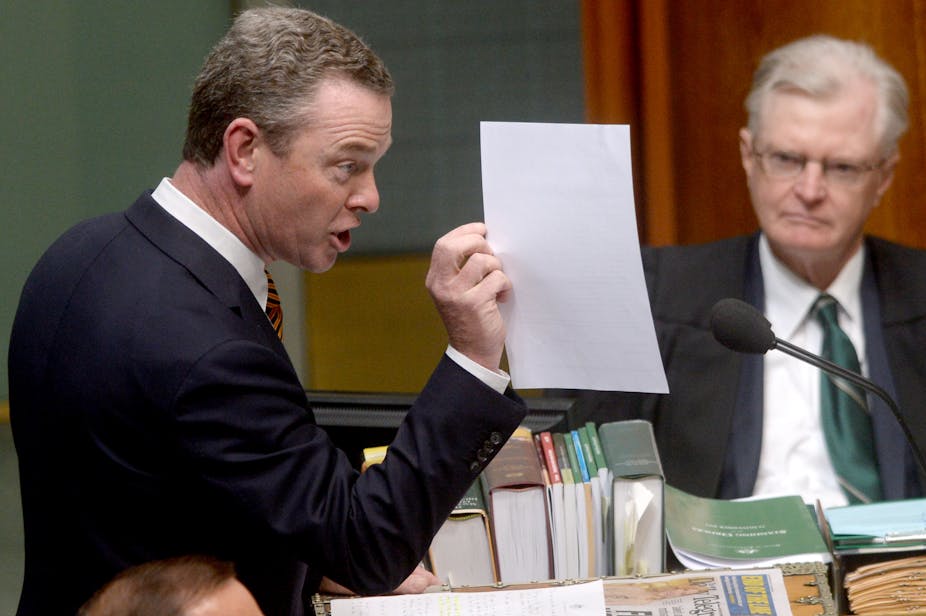The government has released its review on the success of the demand-driven system of higher education funding, implemented by the former Labor government. The demand-driven system uncapped Commonwealth supported university places, and instead implemented a supply-and-demand model of higher education funding. Gwilym Croucher has provided a most useful summary of the main proposals of the final report of the review of the demand-driven funding system by former education minister David Kemp and his former adviser and active Conversation contributor Andrew Norton.
One issue he didn’t discuss in the limited space available was how the reviewers responded to the term of reference asking them to “recommend possible areas for improvement to ensure that the system … is fiscally sustainable”. This has been a concern of people who might otherwise support the demand-driven system.
Some object that the demand-driven system is maintained at the expense of cuts in other higher education spending. Both Labor and the Coalition have proposed this while in government (but each has opposed while in opposition!). Others believe that spending on increasing student access should be a lower priority than increasing spending on research.
The demand-driven system increases two lines of government spending, and Kemp and Norton propose two corresponding revenue measures. The biggest increase in government spending resulting from removing caps on bachelor places at public universities has been in the government subsidy for each bachelor place. The review found this increased from $4.1 billion in 2009 (before enrolment caps were relaxed) to $6.1 billion in 2013 and estimates it will climb to $7.2 billion by 2016-17.
The reviewers found that the fiscal sustainability of the demand-driven system and university revenues can be most equitably secured by cutting government subsidies and increasing student tuition fees by a corresponding amount, although they don’t express it so directly. Norton presents his full argument for changing the balance in course financing from government subsidies to student fees in his report Graduate Winners for the Grattan Institute. He also discussed this in The Conversation.
The other major increased cost of the demand-driven system has been in HELP loans that students take out to pay their tuition fees. The main costs are in the subsidised interest rate the government charges on loans and debts not expected to be repaid. The budget papers estimate these costs will be $1.5 billion in 2014-15 increasing to $1.75 billion in 2016-17, although not all this increase will be due to the demand-driven system.
Kemp and Norton find that a loan fee could help ensure the fiscal sustainability of the demand-driven system. The government charges a loan fee of 25% for all students enrolled in an undergraduate place not subsidised by the government. For historical reasons it does not charge a loan fee for postgraduate places not subsidised by the government nor for undergraduate places subsidised by the government.
Kemp and Norton argue that all student borrowers should be charged the same loan fee, but don’t say what it should be. However, their example is of the student contribution for a year of engineering, which is $8,613. A loan fee would be added to the loan being taken out. If the loan fee were 10%, the resulting debt would be $9,474.
The report notes that a major review of student loans would consider a wide range of issues. Many of these were considered by Norton in his report for the Grattan Institute on Doubtful Debt, which he also discussed in The Conversation.
Norton’s main proposal in that report is to remove the anomaly whereby HELP debts, unlike all other government and private debts, are not recovered from deceased estates. Norton proposes asset-contingent HELP repayment for estates over $100,000.
Norton also considers debts of former students who work overseas. This is a very small problem for Australia since most of the modest number of former students who go overseas return after a few years, merely deferring their loan repayments for that time. However, for some reason this annoys some analysts. Norton proposes that former students be required to make a minimum annual payment of $2,100 while overseas.
A more elegant proposal has been made by Peter Bentley, a research fellow at the LH Martin Institute, in one of his several astute comments on The Conversation. Bentley proposes that the interest subsidy on debt be removed during years where debtors are not residents in Australia. The Australian Tax Office could just add interest to the debts of all former students each year for which they do not file a tax return in Australia.
Unfortunately it is still necessary to reinforce that Australia’s higher education finance challenge is not due to high government spending. The OECD reports in Education at a Glance that Australian public expenditure on tertiary education is only 0.8% of gross domestic product, far below the OECD average of 1.1%.
Contrary to the overwhelmingly dominant discourse in Australia, the core issue in Australian public finance is not spending but revenue: tax is only 26.5% of GDP in Australia, the fifth lowest in the OECD, and way below the OECD average of 34.1%.

